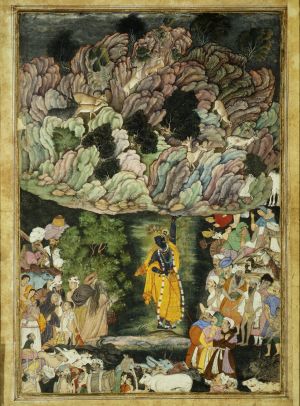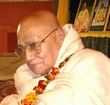

Harivamsa [The Legend of Hari (Krishna)], Circa 1590–95; Mughal, Akbar period (1556-1605)
Attributed to Probably Lahore, India
Ink, colors and gold on paper; H. 11 3/8 in. x W. 7 7/8 in. (28.9 x 20 cm)
Purchase, Edward C. Moore Jr. Gift, 1928 (28.63.1)
Photograph copied with permission of the Metropolitan Museum of Art
Sri Krsna saw that His father Nanda Maharaja and other milkmen had collected many articles for the Indrayag (oblation ceremony for the worship of Indra). Sri Krsna asked His father about the utility of performing such a function. Nanda Maharaja said that if Indra, the presiding deity of the clouds was propitiated, there would be rainfall at the appropriate time. Thereby, paddy crops and grasses would be grown and that would be helpful for their livelihood and for the sustenance of the cows. Nanda Maharaja again said, If we neglect to perform our hereditary custom and duty, we will never get eternal welfare. After hearing this from His father and other milkmen, in order to infuriate Indra, Sri Krsna made the Vrajavasis (residents of Vraja) understand the futility of the worship of Indra and convinced them of the efficacy of worshipping Govardhana: Indra is a demigod without any hold over the fruits of actions. He cannot award bad fruit for a good action and good fruit for a bad action. Birth and death, happiness and affliction are due to the actions of the individual souls. Even worldly actions are the cause of enmity, friendship and indifference. Indra cannot undo the fruits of actions. Although cultivation, trade, protection of cows and money-lending are the livelihood of the vaisyas (trader class of society), the Vrajavasis have only accepted protection of the cows as their principal means of livelihood.
The residents of Vraja-dhama live in the forests and mountains; therefore, cities, crowded human habitation and houses are not good for them. Therefore, they should start an oblation function for the worship of the cows, brahmanas and mountains. Just as an unchaste lady who leaves her husband cannot get actual welfare by serving another person, similarly, the Vrajavasis cannot get actual welfare by serving others, leaving the service of Giriraja Govardhana Who is their actual shelter. Krsna advised the milkmen of Vraja-dhama to worship Giriraja Govardhana with all the articles collected for the Indrayag. He also advised them to bring milk, yoghurt and other milk products to cook different preparations of food, viz. Payasa (preparation of milk, rice and sugar), Mudgasupa (soup prepared from a kind of pigeon pea or pulse), Pistaka and Saskuli (sweet preparations made of rice, coconut, sugar and milk). Krsna also directed them in the method of worship of Giriraja Govardhana: It should be done by the ceremony of giving away cows and offering honorarium to the Vedic brahmanas who will perform the oblation. Brahmanas should be served with good preparations of food. After that, all others, including the Candalas (lowest caste), fallen persons and dogs should be served with appropriate offerings.
Cows should be served with fresh grass. After Govardhana-puja, everyone should be adorned with ornaments, good dresses and anointments and should sit down to honour prasada. Lastly, everyone should circumambulate Govardhana mountain with the cows, brahmanas and the Fire-god. Being enchanted and subdued by his deep parental affection, Nanda Maharaja worshipped Giriraja Govardhana and all the brahmanas properly with all the articles collected for the Indrayag, as per the desire of his beloved son Sri Krsna. After that, while serving the cows with grass and straw, Nanda Maharaja performed parikrama of Govardhana with all the gopas and gopis, with the cows leading in front.
All the gopas were adorned with beautiful ornaments and the gopis sitting on the bullock-carts performed Govardhana parikrama while constantly singing the glories of Krsna. To proclaim to the Vrajavasis that Giriraja Govardhana is non-different from Krsna, Sri Krsna repeatedly and loudly uttered the words, I am the mountain Govardhana, and began to eat all the offerings given to Govardhana by extending thousand of hands. In another Form of Gopala, the son of Nanda Maharaja, Krsna made obeisances to His own manifested Form of Govardhana. Sri Krsna Himself introduced the practice of making prostrated obeisances to Govardhana as well as the circumambulation of Govardhana. Those who disregard Govardhana will be killed by Him in the form of serpents, etc.
Devaraja Indra, the emperor of the demigods, became furious at the Vrajavasis for stopping the Indrayag. Indra oppressed the Vrajavasis by incessant heavy rainfall and a strong hailstorm-like cataclysm. All the Vrajavasis were severely distressed and took shelter of Sri Krsna. Sri Krsna then protected them by lifting Govardhana with His left hand. Later on, Devaraja Indra could understand his mistake and came to Krsna with the Surabhi cow. He worshipped Krsna and prayed to Him to forgive his offence. Giriraja Govardhana is identical with Krsna and He is also the foremost servitor of Krsna.
Srila Raghunatha Dasa Gosvami prays to Giriraja Govardhana as follows:
giri-nrpa! haridasa-sreni-varyeti-namaO Gririraja Govardhana, when your nectarean name was uttered from the lotus lips of Srimati Radhika in Srimad-Bhagavatam (10.21.18), 'Hantayam adrir abala hari-dasa-varya', i.e. 'O simple-hearted innocent gopis, this mountain is foremost amongst all the servitors of Sri Hari,' then you were consecrated by all the Vedas as the new beautiful tilaka (sandalpaste mark) of Vraja-dhama. I therefore pray to you to bestow me a dwelling place in your vicinity.
mrtam idam uditam sri-radhika-vaktra-candrat
vraja-nava-tilakatve kapta vedai sphutam me
nija-nikata-nivasam dehi govardhana tvam
(Sri Govardhana-vasa-prarthana-dasakam, verse 8)
The Supreme Lord Sri Krsna stopped the worship of the demigods and introduced the worship of Govardhana, i.e. He introduced the service of Krsna and Krsna-bhaktas. One meaning of Govardhana is to enhance the sense-organs, so Govardhana-puja signifies the enhancement of the transcendental eternal spiritual sense-organs of Krsna and Krsna-bhaktas.
Since heaps of various items of cooked vegetable dishes were offered to Giriraja Govardhana in Govardhana-puja, this festival is also well-known as the Annakuta Festival. Sri Govardhana-dhari Gopala was originally installed by Vajra (the grandson of Krsna and son of Aniruddha). Due to Srila Madhavendra Puripada's extraordinary pure devotion, Govardhana-dhari Gopala reappeared in Govardhana near the bank of Govinda-kunda. Madhavendra Puripada performed the Annakuta Festival in Kali-yuga. This topic is narrated in detail in the Caitanya-Caritamrta (Madhya-lila, chapter 4).
![[BVML Home Page]](../grfx/bml_logo.gif)
